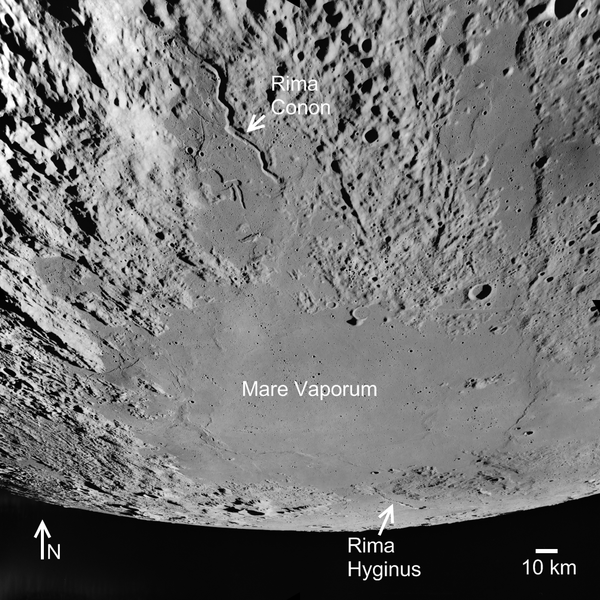
| Project Home | About the Scans | Browse Gallery | Image Map | Support Data | Resources | Ephemeris |
Featured Image - (05/26/2009)
Mare Vaporum
The Moon's surface records billions of years of geologic activity, Mare Vaporum (shown here in an oblique Apollo 17 metric frame; Figure 1) is a good example of this. Mare Vaporum is a deposit of mare basalt located between the southwest rim of the Serenitatis basin and the southeast rim of the Imbrium basin. The highlands materials surrounding Vaporum are covered by ejecta from the Imbrium basin to the north. The circular shape of this mare basalt deposit suggests that the mare actually filled an ancient basin or large impact crater that was buried by Imbrium ejecta. The mare basalts themselves filled the basin later, and are thought to be Eratosthenian in age. The upcoming Lunar Reconnaissance Orbiter Camera will provide high-resolution (0.5 m/pixel) imaging data from all of the lunar mare basalt units, enabling more accurate crater-counting statistics than ever before. These statistics will allow lunar scientists to derive estimates of mare basalt ages, which will help lunar scientists to select the most geologically interesting locations to be explored by future astronauts.
Figure 1. Oblique Apollo Metric Camera
photograph of Mare Vaporum, with key features highlighted. In this
image, we are looking south; the Imbrium basin is to the North (Apollo
Image AS17-M-1674 [NASA/JSC/Arizona State
University])
References:
Apollo
Over the Moon: A View From Orbit (1978) H. Masursky, G. W. Colton,
F. El-Baz, eds. NASA SP-362.
Wilhelms, Don E. (1987) The Geologic History of the Moon,
U. S. Geological Survey Professional Paper 1348.

|
|
Space Exploration Resources |
|
 LPI LPI
|
